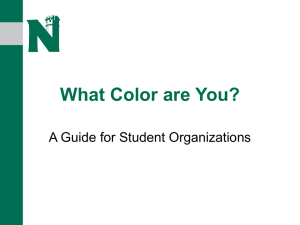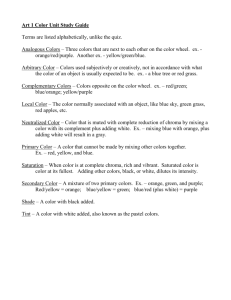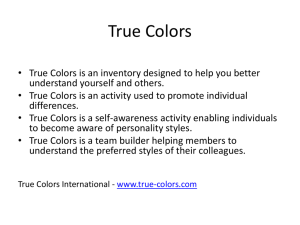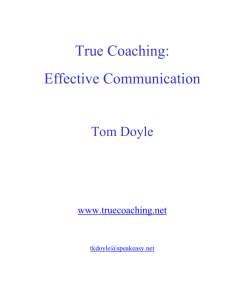Learning Styles
advertisement
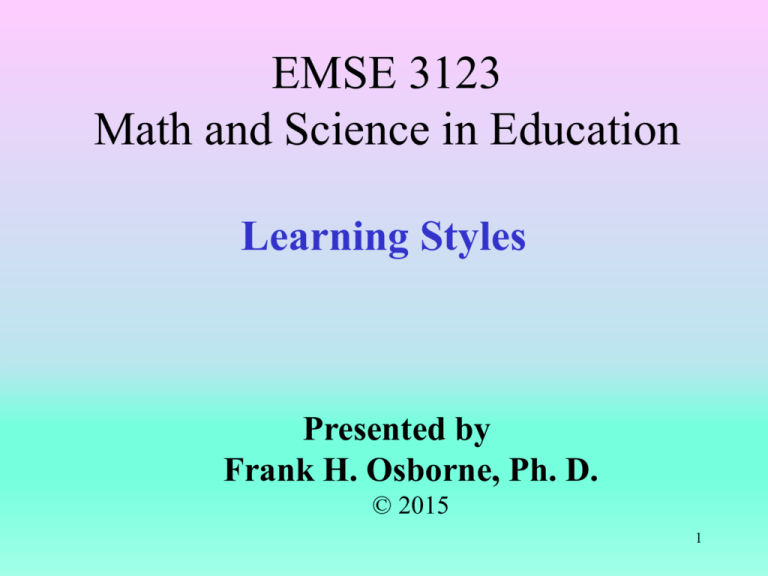
EMSE 3123 Math and Science in Education Learning Styles Presented by Frank H. Osborne, Ph. D. © 2015 1 Introduction • The process of teaching and learning involves Learning Styles. Early work in this area was done by Anthony Gregorc in the 1980s. He recognized the following learning styles. – – – – Concrete Sequential Abstract Sequential Abstract Random Concrete Random 2 Introduction Additional work on these styles was done by Kathleen Butler. More recently, learning styles have been described by W. Kirby and co-workers. The basic learning styles are identified using four colors. This usage is known as the True Colors system. 3 The True Colors System In the True Colors system, there are four personality types. These are represented by colors and are directly related to teaching and learning styles. See the references for more details and information. 4 Gold Type--Traditional Gold • The gold type corresponds to the Concrete Sequential style. – Respects authority, rules, policies and procedures. – Steady, faithful, dependable, prepared and efficient. – Remembers the traditions that work. Values family. – Work comes before play. Practical, systematic, orderly. 5 Gold Type--Traditional Gold • The gold type corresponds to the Concrete Sequential style. – Identifies with groups. Strives for a sense of security. – Thorough, sensible, punctual, conventional, proper. – A right way to do everything. Stick-toitiveness. – Evaluates actions as right or wrong. – Stable, organized, punctual, helpful. 6 Green Type--Visionary Green • The green type corresponds to the Abstract Sequential style. – Looks forward and sees impact of actions taken now. – Explores all facets before deciding. Checks for accuracy. – Careful planner, systematic, enlivened by work – Status quo buster, designer of change, inventive 7 Green Type--Visionary Green • The green type corresponds to the Abstract Sequential style. – Systematic, logical, theoretical, self-sufficient – Often not in the mainstream, persistent, thorough – Intellectual, inquisitive, impartial, improvement oriented 8 Orange Type--Adventurous Orange • The orange type corresponds to the Abstract Random style. – – – – – "Just do it!", action oriented Quick-witted, charming, spontaneous Playful, injects fun into work Lives in the here and now, risk taker, creative Enjoys diversity, variety, competition 9 Orange Type--Adventurous Orange • The orange type corresponds to the Abstract Random style. – – – – – Multi-tasker, cheerful, energetic, bold Quick thinking and acting, takes charge High visibility performer, accepts challenges Enjoys problem solving, negotiator Performs well under pressure, resilient 10 Blue Type--Nurturer Blue • The blue type corresponds roughly to the Concrete Random style. – – – – – Sensitive to the needs of others Sincere, expresses appreciation Cooperative, collaborative, creative Caring, team builder and player People person, engages others 11 Blue Type--Nurturer Blue • The blue type corresponds roughly to the Concrete Random style. – – – – Artistic, inspirational, spiritual Inclusive, mediator, peacemaker Idealistic, intuitive, romantic, loyal Seeks unity and harmony, caretaker 12 True Colors and Teaching Styles • Gold--your teaching style is Institution Oriented – Your classroom is organized with structured routines. – Dependable, consistent classroom management. – Good students are the building blocks of the future. You feel responsible for their education. – Organize learning in step-by-step format. 13 True Colors and Teaching Styles • Green--your teaching style is Subject Oriented – You are most proficient when you are free to develop the competence and intelligence of your students. – You create new procedures reflecting advances in technology and culture. – You enjoy giving students new insights and knowledge gathered from your research. – Use cause and effect approach to develop the reasoning ability of students. 14 True Colors and Teaching Styles • Orange--your teaching style is Action Oriented – Give students information that is useful immediately. – See direct results by using hands-on methods as opposed to theoretical methods. – Classroom is dynamic and exciting by using an unstructured, unpredictable approach. – Direction is dramatic and spontaneous. – Provide a variety of action experiences. – Teaching style is dynamic and unplanned. 15 True Colors and Teaching Styles • Blue--your teaching style is Student Oriented – Nurturing and supporting the growth of your students. – Compassion for others makes it a joy to work with students. – Best teaching is when there is a rapport with the students. – Use imagination as a teaching tool. – Students are involved in the learning process. – Best using individualized instruction. – Operate a democratic classroom. 16 True Colors and Learning Styles • Gold--their student learning style is Structured – Work best when course content is structured and clearly defined. – Foundations should be presented first before the abstract ideas and concepts are introduced. – Work best with rules and directions. – Thrives on routine and orderliness--is punctual and dependable. 17 True Colors and Learning Styles • Green--their student learning style is Independent – Work best independently when exposed to the driving force or overall theory behind the subject. – New ideas and concepts arouse their curiosity and they enjoy interpreting them before adding them to accumulated knowledge. – Logical, theoretical, curious. – Learn best independently. 18 True Colors and Learning Styles • Orange--their student learning style is Competitive – Perform well in competition, especially when there is a lot of action. – They enjoy games, hands-on activities, fun and excitement. – Put learned information to immediate use. – Best when applying skills learned in school to the real world. – Likes to be on stage--competitive. 19 True Colors and Learning Styles • Blue--their student learning style is Interactive – Work best in an open, interactive atmosphere. – Thrive in a humanistic, people-oriented environment. – Want the teacher to value them as persons, and respect their feelings. – Verbal and good with languages, imaginative and abstract. – Social--work best in group settings. 20 – Sensitive to rejection and conflict with teachers. True Colors: Teaching and Learning The Gold Teacher Gold Student: Student and teacher maintain great rapport. Student appreciates the structure and organization provided by the teacher. Gold student responds well. Green Student: Combination works only if Green student is interested in the subject matter and is given freedom to explore ideas. Unlike the Gold teacher, the Green student is oblivious to rules and needs to understand that the rules are logical and necessary. 21 True Colors: Teaching and Learning The Gold Teacher Orange Student: Gold teacher demands order and appropriate behavior while Orange student needs spontaneity, fun and quick action. Orange student may react with rebellion or hostility when placed in a Gold classroom atmosphere. Blue Student: Blue student follows the rules of Gold teacher as long as they are fair and there is personal consideration. Blue student cooperates when it is felt that Gold teacher cares for student individuality. 22 True Colors: Teaching and Learning The Green Teacher Gold Student: Green teacher may not always meet the needs of Gold student. Independent thinking of the teacher may not be appreciated by the Gold student. Gold student may have difficulty in grasping material unless it is presented in concrete ways. Green Student: Green student maintains great rapport and cooperation with Green teachers. Student appreciates the stimulating and creative classroom environment. 23 True Colors: Teaching and Learning The Green Teacher Orange Student: Green teacher's classroom has atmosphere of independence and freedom of thought. Permits Orange students to express their needs and establish their own styles. Green teacher can be perceived as too theoretical by Orange student creating the impression that the teacher is out of touch. Blue Student: Blue student responds to Green classroom atmosphere as long as it is personally relevant and stimulating to a creative imagination. Unlike the Green teacher, Blue student values feelings and interpersonal communication above ideas and concepts. 24 True Colors: Teaching and Learning The Orange Teacher Gold Student: Possibly problematic. Gold student prefers structure and organization while Orange teacher prefers spontaneity and excitement in the classroom. Gold student strives for perfection and enjoys being validated for neat and accurate work. Green Student: Green student needs to be attracted to the subject matter in order to respond well to the classroom environment. Unlike Orange teacher, Green student values ideas and concepts above immediate action. 25 True Colors: Teaching and Learning The Orange Teacher Orange Student: Orange student appreciates the atmosphere and freedom of the Orange classroom. Responds favorably to hands-on approach to learning. Both work well together. Blue Student: Combination works well if Orange teacher allows Blue student to be creative and show personal concern. Student may have difficulty making quick decisions and could have trouble completing tasks. Orange teacher's direct mode of criticism may not be appreciated. 26 True Colors: Teaching and Learning The Blue Teacher Gold Student: Gold student responds to Blue teacher if a regular and predictable schedule is maintained. Gold student will follow the rules but may not exhibit the creativity the Blue teacher is looking for. Green Student: Green student responds well to the Blue classroom atmosphere as long as subject matter and curiosity are continually reinforced. Unlike Blue teacher, Green student is less concerned about the feelings of others and will express opinions regardless of their effects on others. 27 True Colors: Teaching and Learning The Blue Teacher Orange Student: Blue teacher has empathy for needs of the Orange student. Orange student may require more hands-on activities, games, etc. than are scheduled by the teacher. Blue Student: Blue teacher and Blue student have a great level of rapport. Blue student appreciates fairness, sensitivity and personal concern expressed by Blue teacher. Blue atmosphere of creativity and social interaction is appreciated by Blue student. 28 References • Gregorc, A. F. The Gregorc Style Delineator. (Columbia, CT: Gregorc Associates, Inc., 1985). • Butler, K. Connections: Learning Styles, Levels of Thinking and Multiple Intelligences (Columbia, CT: The Learner's Dimension, 1993). • Kirby, W., L. Kirby, L. Riggs and J. Helliweg. Using your True Colors Knowledge. (http://www.uwsp.edu/education/wkirby/pluralis/TrueColorsUse.htm). • Winning-solutions.com. True Colors Personality Types. (http://www.winningsolutions.com/Trainings/True_Colors/truceolor.html). • Niskanen, J. True Colors and Teaching Styles. (http://www.geocities.com/jeniskanen/), 2004. 29 The End 30
